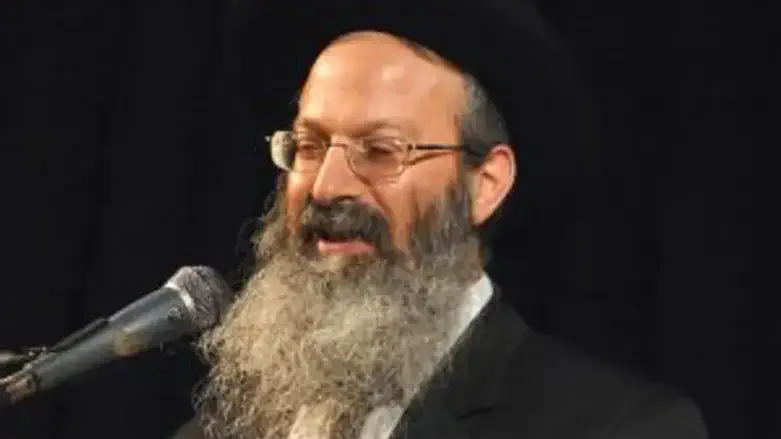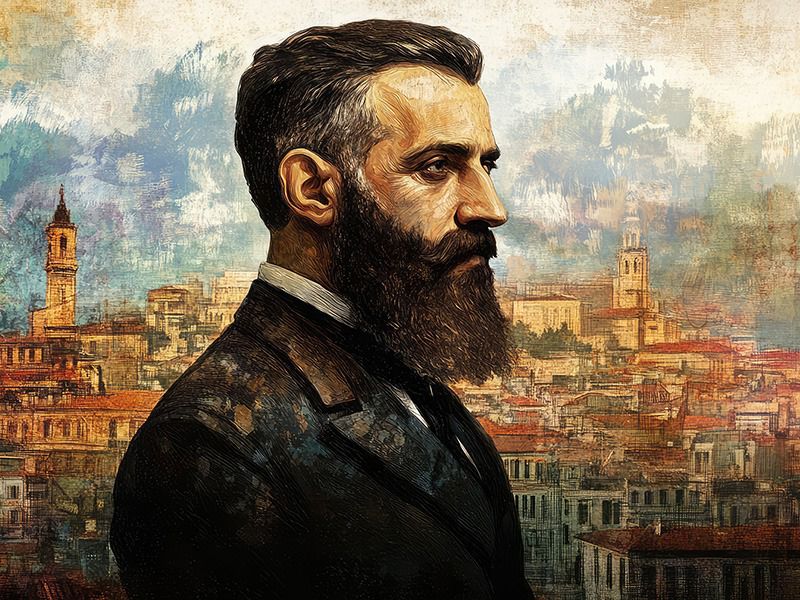

Herzl’s Personality
In his private life, Herzl was secular; such was his education. In his personality, he was noble and moral, and from his diaries, it is evident that from his youth, he had special moral sensitivity. The nation’s suffering and afflictions touched his heart, and since he was seized by the Zionist vision, he was completely swept away with passion, and sacrificed himself without reserve for the restoration of the Jewish people, and for the salvation of his persecuted, tortured and groaning Jewish brothers.
Among most leaders we find personal pettiness, competitiveness, and a desire to also provide for their own family - often at the expense of the public treasury. Herzl was completely different. He did not take money from the movement, instead he dedicated all his wealth to it, and after his death, his family was left in poverty.
The Picture of Herzl in Rabbi Tzvi Yehuda’s Room
In the room of our teacher and mentor, Rabbi Tzvi Yehuda HaKohen Kook of blessed memory, hung several pictures, including that of his father, Maran Rabbi Kook of blessed memory, the Aderet and the Chofetz Chaim, a picture of the entire Land of Israel from the magazine ‘HaSulam’, and in an honored place, the picture of Benjamin Ze’ev Herzl. A Torah scholar from Haredi circles told me that in his youth, he thought to study at Merkaz HaRav Yeshiva, but when he saw the picture of the secular Herzl in Rabbi Tzvi Yehuda’s room, he changed his mind, and went to study at the Ponevezh Yeshiva. Rabbi Tzvi Yehuda, however, was not concerned about the opinion of those who did not understand the great value of the Zionist movement and its founder.
My uncle Rav Avraham Remer of blessed memory related that once Herzl’s picture disappeared, and Rav Tzvi Yehuda suspected that perhaps one of the students had wanted to “educate him”, and hid the picture. Rav Tzvi Yehuda was adamant and did not want to deliver his scheduled lecture, for if there was someone among the students who did such a thing, how was it possible to continue to teach? First, the problem must be dealt with, so that items not be taken without permission.
When Rav Avraham asked permission to move the small bookcase under the place where the picture had hung- as perhaps it had fallen there - Rav Tzvi Yehuda refused to agree, and continued to be adamant about the absence of the picture. When Rav Avraham insisted on searching for the picture behind the bookcase, Rav Tzvi Yehuda spoke to him severely, and once again, said that first, the picture must be returned, and only then, would he continue teaching. Finally, when he agreed that Rav Avraham could move the bookcase, the picture was found, and hung back in its place. Rav Tzvi Yehuda was extremely happy, and found it necessary to comfort my uncle Rav Avraham for not accepting his words at first. He then continued giving the class, speaking about Herzl and his endeavors (see in the collection ‘Gadol Shimusha’ p. 54).
The Attitude of Rabbi Reines
Rabbi Yitzchak Yaakov Reines of blessed memory (1839-1915), rabbi of Lida, was among the great rabbis of his generation. When he was about sixty years old, he joined the Zionist movement, and founded the Mizrachi movement within it.
Rabbi Reines was older than Herzl by about twenty years. He met with him several times and corresponded with him regularly, and therefore, his position toward him carries great weight. In general, Rabbi Reines was impressed that, relatively speaking, for a person who had not received a Jewish education, Herzl related to Judaism and the commandments with great respect. He was impressed by Herzl’s eagerness to finish the discussions of the Third Zionist Congress (in 1899) before the entrance of the Sabbath, “for we do not intend to touch (harm) religion in any way” (Ish HaMeorot, page 108).
His impression stemmed from the fact that in those days, often secular people scorned religion, and clashed with it spitefully. Rabbi Reines wrote to Herzl several timescomplaining about the desecration of the Sabbath and kashrut in the branches of Russian Zionists, and Herzl always replied he would do his best to rectify the wrongdoing.
After Herzl’s death, Rabbi Reines wrote: “God as my witness, the death of our leader made a crushing impact on me, and will cast me upon a bed of ailment.” “And all the people of heart in Israel will weep, and also all the people of knowledge in the entire world will weep.” However, we must not cease the work because of the great disaster. For Zionism is a “historical necessity,” Herzl did not give birth to it, but “it gave birth to Herzl, and made him what he was.”
Zionism lived in the heart of the people thousands of years before Herzl was born, but it was in a dormant state in the hiding of the Jewish heart, “and we did not know the way in which we should walk, and the thing which we should do.” Herzl brought the idea out of its slumber and breathed life into it, which will continue even after his death (Ish HaMeorot, page 239).
Determining the Attitude Toward Herzl
Over the years, among the opponents of Zionism, there were those who claimed that Herzl’s goal was to secularize the Jewish people, and they searched through his writings and found passages inconsistent with Jewish tradition, and in so doing, distanced many Torah observers from his figure. However, over the years, anyone who truly wished to know his personality, realized that his intention was pure - the salvation of the Jewish people, and the restoration of their honor and heritage.
As a person who received a secular education and earned a respected position in non-Jewish society, there was almost no chance that he would become acquainted with Torah and its commandments. In those days, there were almost no chozrim betshuva (returnees to Torah observance). And yet, Herzl became a great chozer betshuva regarding the Jewish people and their heritage, and reached a supreme level in this area, to the point where the words of our Sages were fulfilled in him: “In the place where penitents stand, even the completely righteous cannot stand” (Berakhot 34b).
And thus, he said in his speech at the opening of the First Zionist Congress (1897): “Zionism is a return to Judaism - even before the return to the land of the Jews.” Even before that (1895), in the process of his return to Jewish identity, he wrote a personal note to himself in his diary: “Our nation is not a nation except in its faith”; “We recognize our connection almost only through the faith of our fathers… Faith unites us.”
In response to those who condemned Herzl as a heretic, Rabbi Tzvi Yehuda felt a sacred duty to defend his status and the honor of Israel, and published a short article titled “To Justify the Righteous” in the ‘HaTzofeh’ (28th of Tammuz 5734) newspaper, in which he wrote: “In the writings of Benjamin Ze’ev Herzl of blessed memory, there are no words of heresy. In his diary writings it is written: ‘Our nation is not a nation except in its faith.’ One who thinks and speaks and writes in such a manner is a man of faith, and not a heretic.”
He further added and noted Herzl's lineage - the “sanctity of racial origin,” in that he was descended from “the holy Gaon Rabbi Joseph ben Solomon Ṭaiṭazaḳ of blessed memory” (Netivot Yisrael part 2, page 593 in the Beit El edition).
Addendum:
How to Behave Regarding Techelet
Q: Rabbi, you wrote in the last column in ‘Revivim’ that there is virtue in wearing techelet in tzitzit. The question is: according to which method to behave regarding the number of techelet threads - Rambam, Ra’avad or Tosafot?
A: Indeed, there are three methods among the Rishonim (early authorities) regarding the number of techelet threads.
- According to many early authorities, the four tzitzit threads are divided into two white and two techelet, for it seems reasonable that they are equal. This is the opinion of Rashi (Menachot 38a “hatechelet”), Tosafot (Menachot 38a “hatechelet”); Rosh (Tzitzit 6); Ravvan, Rid, R”Sh miShantz, HaItur, Smak, Yerei’im and Nimukei Yosef. And thus wrote many poskim (Jewish law arbiters) straightforwardly, including: Tur (Orach Chaim 11), Levush (11, 4), Olat Tamid (9, 5), Shulchan Aruch HaRav (11, 1) and Mishnah Berurah (9, 7; 14).
- In contrast, according to the Rambam (Tzitzit 1, 6; Responsa 576) and the Ra’avad (there), one should give “one techelet thread” as the simple meaning of the Torah’s language. According to the Ra’avad one must give one techelet thread and three white ones, and thus wrote the Aruch (entry, techelet), the Meiri (Yevamot 5, 2), and Riaz (Tzitzit 223). And thus decided the Gra (Yahel Or on Zohar Pinchas and in his glosses to Sifrei Parashat Ki Tetze) and the Chida (Chomat Anach 1 Shelach 10).
- And according to the Rambam, the intention is half a thread which is one of eight threads, with which one wraps the white threads. And thus wrote his son R’ Avraham, Sefer HaManhig (242) and also R’ Perachiah (Shabbat 25, 2), Sefer HaKaneh, Sha’ar HaKavanot (discourse 4 on the matter of tzitzit) and Magid Meisharim (Parashat Shelach). And to this tended Mishkenot Yaakov 13, and thus decided the Or Sameach (Tzitzit 1, 6).
And there are those who wrote “thread” without explaining whether their intention is like the Rambam or like the Ra’avad, including Rav Shmuel bar Chafni Gaon, the Ramban and Rabbenu Bachya (Numbers 15, 38), and also in the Zohar (part 3, 175b).
In practice, although each of the methods has its place, and anyone who follows any of them fulfills the commandment, my inclination is toward the method of the Ra’avad, whose method is the deciding one between the two methods, and like it wrote the Gra and the Chida. And thus, it seems more reasonable that they dyed a complete thread in techelet, and as emerges from Eruvin (96, 2), in the law of one who finds a techelet thread where they were puzzled how they would know that it was made for the sake of tzitzit, and they did not answer that one can know this from the fact that only half of it is dyed.
How to Wrap
From the perspective of the law, in all forms of knots and wrappings one fulfills the obligation, as explained in the Gemara (Menachot 39a). And in this too, my inclination is like the Ra’avad (Tzitzit 1, 7) according to Rav Netronai Gaon, Rabbenu Gershom (Moshav Zekenim Numbers 15, 38). Because in this way one continues to behave as with the white as explained in the Shulchan Aruch (Orach Chaim 11, 14), that one makes five knots and four sections, which in total add up to 39 wrappings. According to the Ra’avad’s method the wrappings are done alternately with a white thread and a techelet thread, when the first and last wrapping in each section are white, except for the second section where they are not precise about it.
This article appears in the ‘Besheva’ newspaper and was translated from Hebrew.
